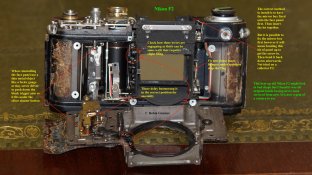mitchamtuell
Member
A few months ago I went to check out a lot of old camera stuff on a local site and found a Nikon F2 with a Nikkor 105mm f2.5 lens on the front. Jackpot, right? Well the lens was full of mold and the camera was completely non-functional and in bad cosmetic condition. The guy didn't care at all and gave em to me for $20 so I figured I'd take them on as repair projects, since they're both super great pieces of equipment when in good condition. I think I've got the lens cleaned up and ready to use, but I've been having some trouble with the camera so I figured I'd ask around here.
Unfortunately there aren't a ton of great resources online for F2 repair. The best I've found is Robin Guymer's great post on this forum. I also found the service manual, which has been less helpful than I had hoped. Before you ask, yes I am aware of Sover Wong. If cost was no issue I'd send it to him, but I'm not really willing to put more money into the camera, and I'm sure I could buy a working one for less than his fee + shipping considering how much work this one needs. Plus I just love fixing things and am excited to learn!
Here are some pictures:
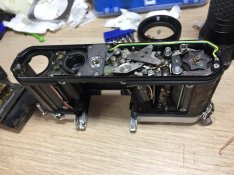
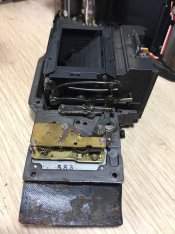
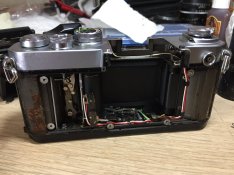
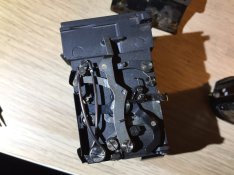

The camera started out entirely jammed. Shutter release wouldn't press and the cocking lever wouldn't move. Got it apart and managed to trigger the shutter by pressing a level on the bottom. Then none of the shutter speeds worked. I lubricated both shutter mechanisms very generously with 3-in-1 and Tri-flow. I've read that typically you use just tiny amounts of sewing machine oil, but I didn't have that and also this stuff was very stuck and rusty. I moved around the components to let oil in and scraped off rust where I saw it. At this point the shutter fired at all speeds, but at the higher speeds the curtain never actually let light in, so I adjusted the curtain tension. I'm pretty sure it's the front curtain tension - it's the one on the upper left in the picture of the bottom of the camera, the one without the green thread lock. After adjusting it every speed appeared to actually work! Through lubrication and working parts around I also got the self timer to work.
I put the front panel and mirror box back on the camera and it... kinda works. It's weird. The shutter button only fires the camera sometimes, and only then when I press it very hard and forcefully. It also seems that the slow speed are much more strained - without the front and mirror they fire easily and for approximately their nominal times, but with it they struggle to complete their cycle (and sometimes fail to entirely), especially at 1 second. When it does fire, the mirror flips correctly and the curtain opens and closes (of course I have no idea about the timing). I've noticed that using the mirror lock-up makes the shutter fire much more consistently and easily, making me think that the tension of the mirror spring has something to do with it. At this point I take it back apart and decide to try adjusting the other curtain tension. I try tensioning and loosening different amounts of each curtain and don't really make any progress. This is pretty much where I'm at now.
What do y'all think? I'm assuming plenty of you here have worked on F2s before. Please feel free to ask for more information or pictures!
Also, assuming everything else works fine, how do I go about setting the shutter speeds? I'm planning to build a simple phototransistor speed tester, but I don't really know the process to use to actually set them.
Thanks!
Unfortunately there aren't a ton of great resources online for F2 repair. The best I've found is Robin Guymer's great post on this forum. I also found the service manual, which has been less helpful than I had hoped. Before you ask, yes I am aware of Sover Wong. If cost was no issue I'd send it to him, but I'm not really willing to put more money into the camera, and I'm sure I could buy a working one for less than his fee + shipping considering how much work this one needs. Plus I just love fixing things and am excited to learn!
Here are some pictures:





The camera started out entirely jammed. Shutter release wouldn't press and the cocking lever wouldn't move. Got it apart and managed to trigger the shutter by pressing a level on the bottom. Then none of the shutter speeds worked. I lubricated both shutter mechanisms very generously with 3-in-1 and Tri-flow. I've read that typically you use just tiny amounts of sewing machine oil, but I didn't have that and also this stuff was very stuck and rusty. I moved around the components to let oil in and scraped off rust where I saw it. At this point the shutter fired at all speeds, but at the higher speeds the curtain never actually let light in, so I adjusted the curtain tension. I'm pretty sure it's the front curtain tension - it's the one on the upper left in the picture of the bottom of the camera, the one without the green thread lock. After adjusting it every speed appeared to actually work! Through lubrication and working parts around I also got the self timer to work.
I put the front panel and mirror box back on the camera and it... kinda works. It's weird. The shutter button only fires the camera sometimes, and only then when I press it very hard and forcefully. It also seems that the slow speed are much more strained - without the front and mirror they fire easily and for approximately their nominal times, but with it they struggle to complete their cycle (and sometimes fail to entirely), especially at 1 second. When it does fire, the mirror flips correctly and the curtain opens and closes (of course I have no idea about the timing). I've noticed that using the mirror lock-up makes the shutter fire much more consistently and easily, making me think that the tension of the mirror spring has something to do with it. At this point I take it back apart and decide to try adjusting the other curtain tension. I try tensioning and loosening different amounts of each curtain and don't really make any progress. This is pretty much where I'm at now.
What do y'all think? I'm assuming plenty of you here have worked on F2s before. Please feel free to ask for more information or pictures!
Also, assuming everything else works fine, how do I go about setting the shutter speeds? I'm planning to build a simple phototransistor speed tester, but I don't really know the process to use to actually set them.
Thanks!








